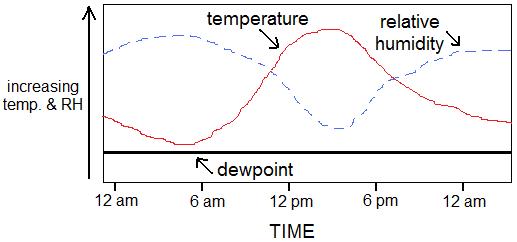01.31.11
Meteorology 101: Elements of Weather – Moisture
Today’s post in the weather education series is on moisture in the atmosphere (e.g., phases, measurements, etc.), one of the seven elements of weather (temperature, pressure, wind, moisture, clouds, precipitation, and visibility).
————————————————–
Phases of Water
Water comes in three phases: gas (water vapor), liquid, and solid (ice). The following figure shows the names for the different phase changes.
Note that when water goes to a higher energy state (read: the molecules are moving faster so the temperature is higher), latent heat energy is absorbed, cooling the atmosphere.
Think about it: when you want to melt some ice, you have to apply some heat…but where does the heat go? The heat is absorbed by the ice, allowing it to melt and then leaving the environment cooler than it was before. Also, think about how you feel cooler when you get out of a pool: water droplets on your skin evaporate, drawing heat from your body and thus leaving you feeling cooler.
The reverse is true as well; when water goes to a lower energy state (e.g., ice to liquid or vapor), latent heat energy is released, warming the atmosphere.
Dewpoint vs. Relative Humidity
Atmospheric moisture can be measured in a variety of ways, the most common being dewpoint temperature and relative humidity.
Dewpoint temperature is an absolute measure of moisture, and the units are the same as those of air temperature (°F, °C, K). The dewpoint is basically the temperature at which the air would reach saturation, if the temperature were to drop. Thus, the higher the dewpoint, the higher the moisture. Dewpoints above 60 °F are indicative of humid conditions, while dewpoints below 40 °F are generally indicative of dry conditions.
Relative humidity is given as a percent, and as it is a relative measure of moisture, a higher relative humidity does NOT necessarily mean there is a high amount of moisture in the air…it ONLY means that the air is closer to saturation.
Think about it: if the air temperature is 30 °F, the dewpoint temperature must be less than or equal to 30 °F (remember, the dewpoint temperature can never exceed the air temperature). So even if the relative humidity is 90%, you still have dry air…it just means you might be close to saturation (maybe it’s foggy or snowing).
Now, let’s say the dewpoint temperature stays the same for 24 hours…what happens to the relative humidity? As the air temperature goes up, the relative humidity goes down (see figure, above)…as the air temperature rises during the day, the difference between the air temperature and the dewpoint becomes greater (thus the relative humidity goes down)…and as the air temperature falls at night, the difference between the air temperature and the dewpoint becomes less (thus the relative humidity goes up, and you may get dew on the grass).
————————————————–
Come back next Monday as we talk about clouds, the next element of weather.


Hurricane Windows: Protect Your Home During a Storm | Natural Disasters said,
February 4, 2011 at 9:12 am
[…] Green Sky Chaser » Meteorology 101: Elements of Weather – Moisture […]
Green Sky Chaser » Meteorology 101: Elements of Weather – Temperature said,
February 8, 2011 at 11:27 pm
[…] Moisture […]
Green Sky Chaser » Meteorology 101: Elements of Weather – Wind said,
February 8, 2011 at 11:27 pm
[…] seven elements of weather (temperature, pressure, wind, moisture, clouds, precipitation, and visibility) can all be boiled down to temperature, pressure, and […]